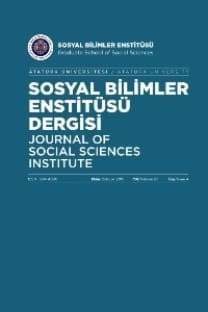From Antaeus to the Bog Queen: Mythological Allusions in Seamus Heaney’s North / Antaeus’tan Bataklık Kraliçesi’ne: Seamus Heaney’nin North Adlı Yapıtında Mitolojik Göndermeler
Abstract: Addressing the Irish Troubles in his “North”, 1995 Nobel Laureate Seamus
Anahtar Kelimeler:
Seamus Heaney, şiir, İrlanda, İrlanda sorunu, mitoloji, bataklık
Addressing the Irish Troubles in his “North”, 1995 Nobel Laureate Seamus Heaney makes mythological allusions and tells of the chaos by using symbolic language. His relevant poems, Antaeus and Hercules myths from Greek mythology are the stories of source power for the Irish and those of their dispossessions. His poems dealing with the cult of Nerthus, the goddess of earth in Scandinavian mythology, are the narratives underlying the cultural kinships between the two geographies, reflecting contemporary practices of cycle of violence. In this sense, the bog queens in ‘Come to the Bower’ and ‘Bog Queen’ appear to be as Nerthus, for whom people were sacrificed to ensure the fertility of the territory in spring, and as Mother Ireland, who needs the blood of her children to survive. While the first group traces back the reasons of hibernation of Ireland, defined as the ‘sleeping giant’, the second one picks the route of violence followed by her loyalties to awaken this giant. Heaney’s preference to hold a mirror to his locale through Greek and Scandinavian mythologies is a result of his desire to show the political and social chaos comprehensively.
Keywords:
Seamus Heaney, poetry, Ireland, Irish Troubles, mythology, bog,
___
Bhroin, C. N. (2011). Mythologizing Ireland. Valerie Coghlan & Keith O’Sullivan (Ed.). Irish Children’s Literature and Culture: New Perspectives on Contemporary Writing. (pp. 7-29), New York: Routledge.Sutton, M. (2013). An Index of Deaths from the Conflict in Ireland. CAIN Web Service, Organisation Summary. http://cain.ulst.ac.uk/cgi-bin/tab2.pl [15.05.2013]. Carson, C. (Winter 1975). “Escaped from the Massacre?”. The Honest Ulsterman, No. 50, pp. 183-186.
Corcoran, N. (1998). The Poetry of Seamus Heaney. London: Faber and Faber.
Coughlan, P. (1997). ‘Bog Queens’: The Representation of Women in the Poetry of John Montague and Seamus Heaney. Michael Allan (Ed.), Seamus Heaney. (pp. 185-205), New York: Palgrave Macmillan.
Foster, T. C. (1989). Seamus Heaney. Dublin: The O’Brian Press.
Foster, J. W. (1995). The Achievement of Seamus Heaney. Dublin: The Lilliput Press.
Haffenden, J. (1987). Seamus Heaney and Feminine Sensibility. Yearbook of English Studies, 17, 89-116.
Hart, H. (Autumn 1989). “History, Myth, and Apocalypse in Seamus Heaney’s North”. Contemporary Literature, 30(3), 387-411.
Heaney, S. (1980). Preoccupations: Selected Prose 1968-1978. New York: Farrar, Straus and Giroux.
Heaney, S. (1975). North. London: Faber and Faber.
Heaney, S. (1972). Mother Ireland. The Listener, 7 December, 790.
Hutchinson, J. (2001 October). “Archaeology and the Irish Rediscovery of the Celtic past”. Nation and Nationalism, 7(4), 505-519.
Johnston, D. (2003). Violence in Seamus Heaney’s Poetry. Matthew Campbell (Ed.), The Cambridge Companion to Contemporary Irish Poetry. (pp. 113-132), Cambridge: Cambridge University Press.
Kearney, R. (1996). Post Nationalist Ireland: Politics, Literature, Philosophy. Florence, KY, USA: Routledge.
Lloyd, D. (1996). Fusions in Heaney’s North. Catharine Malloy & Phyllis Carey (Ed.). Seamus Heaney: The Shaping Spirit. (pp. 82-90), Newark & London: University of Delaware Press & Associated University Presses.
Longley, E. (1997). ‘Inner Émigré’ or ‘Artful Voyeur’? Seamus Heaney’s North. Michael Allen (Ed.), Seamus Heaney. (pp. 30-63), London: Macmillan Press.
Moloney, Karen M. (2007). Seamus Heaney and the Emblems of Hope. Columbia, MO, USA: University of Missouri Press.
Morrison, B. (1982). Seamus Heaney. London-New York: Routledge.
O’Brien, C. C. (1997). A Slow North-east Wind: Review of North. Michael Allan (Ed.), Seamus Heaney. (pp.25-29), London: Macmillan Press.
O’Neill, C. L. (1996). Violence and the Sacred in Seamus Heaney’s North. Catharine Malloy-Phyllis Carey (Eds.). Seamus Heaney: The Shaping Spirit. (pp. 91-105), Newark-London: University of Delaware Press-Associated University Press.
Parker, M. (1993). Seamus Heaney: The Making of the Poet. London: Macmillan.
Tobin, D. (1999). Passage to the Center: Imagination and the Sacred in the Poetry of Seamus Heaney. Kentucky: The University Press of Kentucky.
Tomlinson, A., Horne, J. (1999). Twentieth Century in Poetry. Florence, KY, USA: Routledge.
Vendler, H. (1998). Seamus Heaney. Cambridge/Massachusetts: Harvard University Press.
- ISSN: 1304-4990
- Yayın Aralığı: Yılda 4 Sayı
- Yayıncı: Atatürk Üniversitesi Sosyal Bilimler Enstitüsü Müdürlüğü
Sayıdaki Diğer Makaleler
Öğretim elemanlarının sınıf yönetiminde kullandıkları güç türleri ölçeğinin geliştirilmesi
Engin ASLANARGUN, H. Merve ERİŞ
Anna seghers'in yedinci şafak adlı romanında tarihin yansıması
Bilim ve teknoloji çağında insan olma sorumluluğu (etik bilinç)
Lise son sınıf öğrencilerinin yılmazlık özelliklerinin duygusal dışavurum açısından incelenmes
